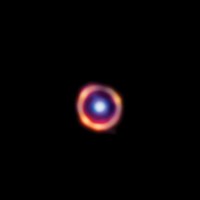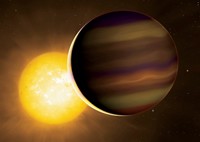Advertisement
Grab your lab coat. Let's get started
Welcome!
Welcome!
Create an account below to get 6 C&EN articles per month, receive newsletters and more - all free.
It seems this is your first time logging in online. Please enter the following information to continue.
As an ACS member you automatically get access to this site. All we need is few more details to create your reading experience.
Not you? Sign in with a different account.
Not you? Sign in with a different account.
ERROR 1
ERROR 1
ERROR 2
ERROR 2
ERROR 2
ERROR 2
ERROR 2
Password and Confirm password must match.
If you have an ACS member number, please enter it here so we can link this account to your membership. (optional)
ERROR 2
ACS values your privacy. By submitting your information, you are gaining access to C&EN and subscribing to our weekly newsletter. We use the information you provide to make your reading experience better, and we will never sell your data to third party members.
Astrochemistry
PAHs lurking among the stars have now been identified
The discovery could help solve space chemistry puzzles but many gaps still remain
by Sam Lemonick
March 18, 2021
| A version of this story appeared in
Volume 99, Issue 10

Scientists have identified two polycyclic aromatic hydrocarbons—1- and 2-cyanonaphthalene—in interstellar space for the first time (Science 2021, DOI: 10.1126/science.abb7535). While many astronomers have been confident for years that polycyclic aromatic hydrocarbons (PAHs) exist in these regions, experts say learning which molecules are out there will help them piece together what chemistry happens in space.
The interstellar medium (ISM)—the space between stars—is vast and empty, containing about 1 atom per cm3. For more than a century scientists have debated what molecules might exist there and how they might react. Astronomers eventually discovered smaller hydrocarbon chains and larger buckyballs in the ISM, but one piece of the puzzle was missing: PAHs. In an email, spectroscopist Anouk M. Rijs of Vrije Universiteit Amsterdam and PhD student Sander Lemmens of Radboud University and the University of Amsterdam, who were not involved in the research, say PAHs “are expected to form the connection” between smaller and larger molecules in ISM chemistry.
Spectroscopic evidence has suggested PAHs are common in the ISM, perhaps representing as much as 25% of its carbon. But it is difficult to know what PAHs are out there, because PAHs made only of carbon and hydrogen have no dipole moment, meaning they give no signal in rotational spectroscopy, the tool used to identify the majority of known molecules in space. That leaves astrochemists unable to test many hypotheses about ISM chemistry.

Brett A. McGuire of the Massachusetts Institute of Technology and colleagues targeted 1- and 2-cyanonaphthalene because these molecules’ polar CN groups give them unique rotational spectra. Other researchers had carefully measured the spectra of these two molecules under conditions simulating the ISM: low molecular density, temperature near absolute zero, and lots of radiation (Mon. Not. R. Astron. Soc. 2018, DOI: 10.1093/mnras/sty557). McGuire's team scrutinized microwave radio signals emanating from the Taurus Molecular Cloud, an area of dust, gas, and young stars about 430 light years from Earth and extracted the signatures of the two molecules from these signals using the lab-derived spectra.
The discoveries confirm “that complex, aromatic molecules are formed in space” and not just in stars, astrophysicist Farid Salama of NASA-Ames Research Center, who was not part of the team, says in an email.
The next step was to understand the role these molecules play in the chemistry of the ISM. Telescope data let the researchers estimate the abundance of 1- and 2-cyanonaphthalene in this region, and they tried to reconstruct the reactions that would produce those molecules. The group ran computer simulations that envisioned two scenarios: smaller molecules reacting to form these cyanonaphthalenes or larger, carbon-based particles breaking down to form them. Neither one alone fit well. The group—as well as others who spoke with C&EN about the work—believes some combination of those scenarios is likely at play and thinks the team’s models may be missing chemistry that could form these molecules.
Ralf I. Kaiser of University of Hawai‘i at Mānoa was more critical. He praised the group’s discoveries (“an ‘A’ from the observational side,” he says), but said they overlooked many known reactions that could explain the two molecules’ observed abundances. McGuire acknowledged the group’s models are incomplete, and says they have appreciated suggestions from Kaiser and others as they update their simulations.
McGuire says the group will turn their sights on other parts of the night sky in search of other molecules in future work.
CORRECTION
This story was updated on March 24, 2021 to correct the statement that Brett A. McGuire's team had collected lab measurements of 1- and 2-cyanonaphthalene at conditions that simulate the interstellar medium. In this work, they used measurements made by another research group.




Join the conversation
Contact the reporter
Submit a Letter to the Editor for publication
Engage with us on Twitter